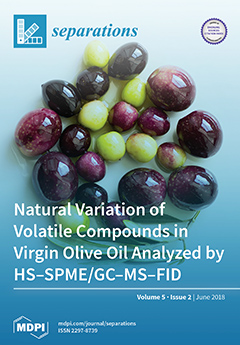Bisphenol A (BPA), 4-nonylphenol (4NP), estradiol (E
2), and ethinylestradiol (EE
2) are considered as endocrine disruptors or mutagens. These compounds are commonly called endocrine disrupter chemicals (EDCs). BPA and 4NP are widely used as plastic additives, lacquers, resins, or surfactants,
[...] Read more.
Bisphenol A (BPA), 4-nonylphenol (4NP), estradiol (E
2), and ethinylestradiol (EE
2) are considered as endocrine disruptors or mutagens. These compounds are commonly called endocrine disrupter chemicals (EDCs). BPA and 4NP are widely used as plastic additives, lacquers, resins, or surfactants, while E
2 is one of the predominant female sex hormones during the reproductive years, and EE
2 is an estrogen derived from estradiol, used in the production of contraceptive pills. All of these can be usually found in wastewater. In Mexico, it is common for water from rivers, lakes, and canyons to be reused for different purposes. Unfortunately, there is little information on the concentration of many of the pollutants present in such bodies of water. To determine the presence of these compounds in samples of wastewater in the Apatlaco River, an accurate and reproducible method was developed by coupling gas chromatography to mass spectrometry (GC-MS). A solid-phase extraction with Chromabond RP-18 cartridges was carried out, and the elution was performed with an acetone/methanol mixture. After isolation, the solvent was removed and a silylation step was carried out using
N,
O-bis(trimethylsilyl)trifluoroacetamide (BSTFA). Recoveries for spiked samples were between 71.8% and 111.0%. The instrumental limits of detection (IDL) ranged between 24.7 and 37.0 ng mL
−1. In total, 16 samples were taken in 2015 at the microbasin of the Apatlaco River, located in the state of Morelos. The maximum concentrations found were 4NP (85.5 ng mL
−1), BPA (174.6 ng mL
−1), E
2 103.6 (ng mL
−1), and EE
2 (624.3 ng mL
−1).
Full article





